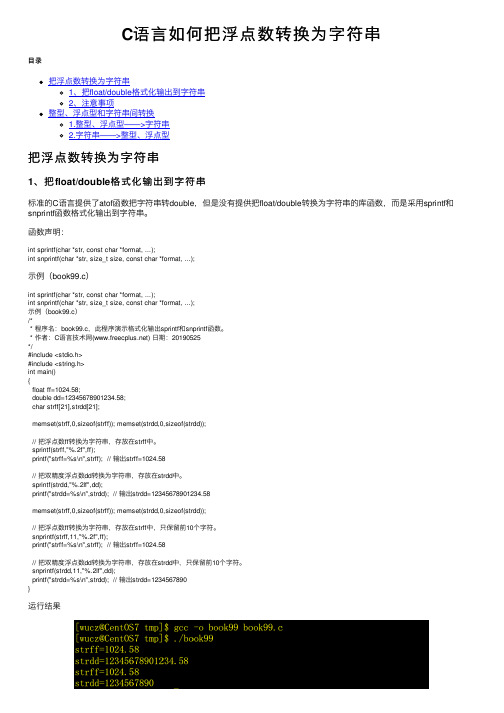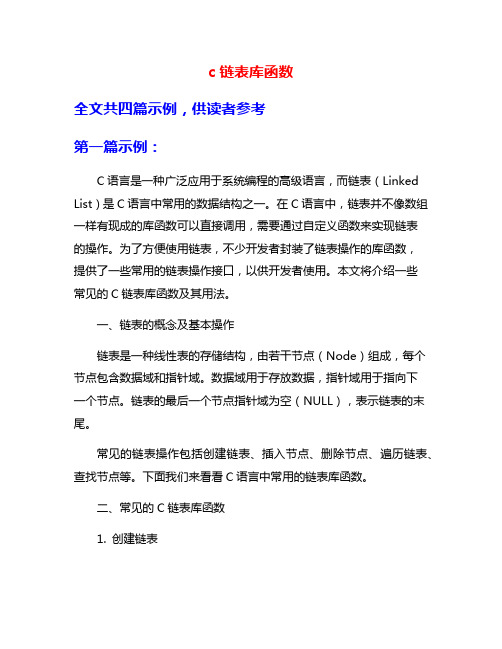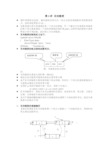用C++编写的双向链表程序示例
C语言如何把浮点数转换为字符串

C语⾔如何把浮点数转换为字符串⽬录把浮点数转换为字符串1、把float/double格式化输出到字符串2、注意事项整型、浮点型和字符串间转换1.整型、浮点型——>字符串2.字符串——>整型、浮点型把浮点数转换为字符串1、把float/double格式化输出到字符串标准的C语⾔提供了atof函数把字符串转double,但是没有提供把float/double转换为字符串的库函数,⽽是采⽤sprintf和snprintf函数格式化输出到字符串。
函数声明:int sprintf(char *str, const char *format, ...);int snprintf(char *str, size_t size, const char *format, ...);⽰例(book99.c)int sprintf(char *str, const char *format, ...);int snprintf(char *str, size_t size, const char *format, ...);⽰例(book99.c)/** 程序名:book99.c,此程序演⽰格式化输出sprintf和snprintf函数。
* 作者:C语⾔技术⽹() ⽇期:20190525*/#include <stdio.h>#include <string.h>int main(){float ff=1024.58;double dd=12345678901234.58;char strff[21],strdd[21];memset(strff,0,sizeof(strff)); memset(strdd,0,sizeof(strdd));// 把浮点数ff转换为字符串,存放在strff中。
sprintf(strff,"%.2f",ff);printf("strff=%s\n",strff); // 输出strff=1024.58// 把双精度浮点数dd转换为字符串,存放在strdd中。
c链表库函数

c链表库函数全文共四篇示例,供读者参考第一篇示例:C语言是一种广泛应用于系统编程的高级语言,而链表(Linked List)是C语言中常用的数据结构之一。
在C语言中,链表并不像数组一样有现成的库函数可以直接调用,需要通过自定义函数来实现链表的操作。
为了方便使用链表,不少开发者封装了链表操作的库函数,提供了一些常用的链表操作接口,以供开发者使用。
本文将介绍一些常见的C链表库函数及其用法。
一、链表的概念及基本操作链表是一种线性表的存储结构,由若干节点(Node)组成,每个节点包含数据域和指针域。
数据域用于存放数据,指针域用于指向下一个节点。
链表的最后一个节点指针域为空(NULL),表示链表的末尾。
常见的链表操作包括创建链表、插入节点、删除节点、遍历链表、查找节点等。
下面我们来看看C语言中常用的链表库函数。
二、常见的C链表库函数1. 创建链表在C语言中,创建链表的函数通常包括初始化链表头节点和链表节点的操作。
```#include <stdio.h>#include <stdlib.h>//定义链表节点typedef struct node {int data;struct node* next;} Node;2. 插入节点插入节点是链表操作中的重要操作,可以在链表的任意位置插入新节点。
常见的插入方式包括头部插入和尾部插入。
```//头部插入节点void insertNodeAtHead(Node* head, int data) {Node* newNode = (Node*)malloc(sizeof(Node));newNode->data = data;newNode->next = head->next;head->next = newNode;}以上是常见的C链表库函数,这些函数可以帮助我们更方便地操作链表。
在实际开发中,可以根据需要自定义更多的链表操作函数,以满足具体的需求。
双向链表练习题

双向链表练习题双向链表(Doubly Linked List)是一种常见的数据结构,它在单链表的基础上扩展,允许链表中的节点同时指向前一个节点和后一个节点。
在这篇文章中,我们将介绍几个双向链表的练习题,帮助读者更好地理解和掌握双向链表的操作。
1. 实现双向链表的节点类首先,我们需要定义一个双向链表的节点类。
节点类包括一个存储值的属性和两个指针属性,分别指向前一个节点和后一个节点。
以下是一个示例代码:```class DLLNode:def __init__(self, value):self.value = valueself.prev = Noneself.next = None```2. 在双向链表的尾部插入节点在双向链表中,可以在链表的尾部插入一个新的节点。
例如,如果链表中已有节点A和B,我们需要在B后插入一个新节点C。
以下是一个示例代码:```def insert_at_end(head, value):new_node = DLLNode(value)if head is None:head = new_nodeelse:current = headwhile current.next is not None:current = current.nextcurrent.next = new_nodenew_node.prev = currentreturn head```3. 删除双向链表中的节点双向链表允许从链表中删除指定节点。
我们可以根据节点的值或位置进行删除操作。
以下是一个根据节点值删除节点的示例代码:```def delete_node(head, value):current = headwhile current is not None:if current.value == value:if current.prev is not None:current.prev.next = current.nextif current.next is not None:current.next.prev = current.previf current == head:head = current.nextreturn headcurrent = current.nextreturn head```4. 查找双向链表中的节点可以根据节点值或位置在双向链表中查找节点。
[转载整理]C语言链表实例
![[转载整理]C语言链表实例](https://img.taocdn.com/s3/m/0aca427eb94ae45c3b3567ec102de2bd9605debe.png)
[转载整理]C语⾔链表实例 C语⾔链表有单链表、双向链表、循环链表。
单链表由数据域和指针域组成,数据域存放数据,指针域存放该数据类型的指针便于找到下⼀个节点。
双链表则含有头指针域、数据域和尾指针域,域单链表不同,双链表可以从后⼀个节点找到前⼀个节点,⼆单链表则不⾏。
循环链表就是在单链表的基础上,将头结点的地址指针存放在最后⼀个节点的指针域⾥以,此形成循环。
此外还有双向循环链表,它同时具有双向链表和循环链表的功能。
单链表如:链表节点的数据结构定义struct node{int num;struct node *p;} ;在此链表节点的定义中,除⼀个整型的成员外,成员p是指向与节点类型完全相同的指针。
※在链表节点的数据结构中,⾮常特殊的⼀点就是结构体内的指针域的数据类型使⽤了未定义成功的数据类型。
这是在C中唯⼀规定可以先使⽤后定义的数据结构。
链表实例代码:1// 原⽂地址 /wireless-dragon/p/5170565.html2 #include<stdio.h>3 #include<stdlib.h>4 #include<string.h>56 typedef int elemType;//定义存⼊的数据的类型可以是int char78 typedef struct NODE{ //定义链表的结构类型9 elemType element;10struct NODE *next;11 }Node;1213/************************************************************************/14/* 以下是关于线性表链接存储(单链表)操作的19种算法 */1516/* 1.初始化线性表,即置单链表的表头指针为空 */17/* 2.创建线性表,此函数输⼊负数终⽌读取数据*/18/* 3.打印链表,链表的遍历*/19/* 4.清除线性表L中的所有元素,即释放单链表L中所有的结点,使之成为⼀个空表 */20/* 5.返回单链表的长度 */21/* 6.检查单链表是否为空,若为空则返回1,否则返回0 */22/* 7.返回单链表中第pos个结点中的元素,若pos超出范围,则停⽌程序运⾏ */23/* 8.从单链表中查找具有给定值x的第⼀个元素,若查找成功则返回该结点data域的存储地址,否则返回NULL */24/* 9.把单链表中第pos个结点的值修改为x的值,若修改成功返回1,否则返回0 */25/* 10.向单链表的表头插⼊⼀个元素 */26/* 11.向单链表的末尾添加⼀个元素 */27/* 12.向单链表中第pos个结点位置插⼊元素为x的结点,若插⼊成功返回1,否则返回0 */28/* 13.向有序单链表中插⼊元素x结点,使得插⼊后仍然有序 */29/* 14.从单链表中删除表头结点,并把该结点的值返回,若删除失败则停⽌程序运⾏ */30/* 15.从单链表中删除表尾结点并返回它的值,若删除失败则停⽌程序运⾏ */31/* 16.从单链表中删除第pos个结点并返回它的值,若删除失败则停⽌程序运⾏ */32/* 17.从单链表中删除值为x的第⼀个结点,若删除成功则返回1,否则返回0 */33/* 18.交换2个元素的位置 */34/* 19.将线性表进⾏冒排序 */35363738/*注意检查分配到的动态内存是否为空*/3940414243/* 1.初始化线性表,即置单链表的表头指针为空 */44void initList(Node **pNode)45 {46 *pNode=NULL;47 printf("initList函数执⾏,初始化成功\n");48 }4950/* 2.创建线性表,此函数输⼊负数终⽌读取数据*/51 Node *creatList(Node *pHead)52 {53 Node *p1,*p2;54 p1=p2=(Node *)malloc(sizeof(Node));55if(p1 == NULL || p2 ==NULL)57 printf("内存分配失败\n");58 exit(0);59 }60 memset(p1,0,sizeof(Node));6162 scanf("%d",&p1->element);63 p1->next=NULL;6465while(p1->element >0) //输⼊的值⼤于0则继续,否则停⽌66 {67if(pHead == NULL)//空表,接⼊表头68 {69 pHead=p1;70 }71else72 {73 p2->next=p1;74 }7576 p2=p1;77 p1=(Node *)malloc(sizeof(Node));7879if(p1==NULL||p2==NULL)80 {81 printf("内存分配失败\n");82 exit(0);83 }84 memset(p1,0,sizeof(Node));85 scanf("%d",&p1->element);86 p1->next=NULL;87 }88 printf("CreatList函数执⾏,链表创建成功\n");89return pHead;90 }9192/* 3.打印链表,链表的遍历*/93void printList(Node *pHead)94 {95if(NULL==pHead)96 {97 printf("PrintList函数执⾏,链表为空\n");98 }99else100 {101while(NULL!=pHead)102 {103 printf("%d\n",pHead->element);104 pHead=pHead->next;105 }106 }107108 }109110111/* 4.清除线性表L中的所有元素,即释放单链表L中所有的结点,使之成为⼀个空表 */ 112void clearList(Node *pHead)113 {114 Node *pNext;115116if(pHead==NULL)117 {118 printf("clearList函数执⾏,链表为空\n");119return;120 }121while(pHead->next!=NULL)122 {123 pNext=pHead->next;124free(pHead);125 pHead=pNext;126 }127 printf("clearList函数执⾏,链表已经清除!\n");128129 }130131/* 5.返回链表的长度*/132int sizeList(Node *pHead)133 {134int size=0;135136while(pHead!=NULL)137 {138 size++;139 pHead=pHead->next;141 printf("sizelist函数执⾏,链表长度为%d\n",size);142return size;143 }144145/* 6.检查单链表是否为空,若为空则返回1,否则返回0 */146int isEmptyList(Node *pHead)147 {148if(pHead==NULL)149 {150 printf("isEmptylist函数执⾏,链表为空!\n");151return1;152 }153154else155 printf("isEmptylist函数执⾏,链表⾮空!\n");156return0;157158 }159160/* 7.返回链表中第post节点的数据,若post超出范围,则停⽌程序运⾏*/161int getElement(Node *pHead,int pos)162 {163int i=0;164if(pos<1)165 {166 printf("getElement函数执⾏,pos值⾮法!");167return0;168 }169if(pHead==NULL)170 {171 printf("getElement函数执⾏,链表为空!");172 }173174while (pHead!=NULL)175 {176 ++i;177if(i==pos)178 {179break;180 }181 pHead=pHead->next;182 }183if(i<pos)184 {185 printf("getElement函数执⾏,pos值超出链表长度\n");186return0;187 }188 printf("getElement函数执⾏,位置%d中的元素为%d\n",pos,pHead->element);189190return1;191 }192193//8.从单⼀链表中查找具有给定值x的第⼀个元素,若查找成功后,返回该节点data域的存储位置,否则返回NULL 194 elemType *getElemAddr(Node *pHead,elemType x)195 {196if(NULL==pHead)197 {198 printf("getEleAddr函数执⾏,链表为空");199return NULL;200 }201if(x<0)202 {203 printf("getEleAddr函数执⾏,给定值x不合法\n");204return NULL;205 }206while((pHead->element!=x)&&(NULL!=pHead->next))//判断链表是否为空,并且是否存在所查找的元素207 {208 pHead=pHead->next;209 }210if(pHead->element!=x)211 {212 printf("getElemAddr函数执⾏,在链表中没有找到x值\n");213return NULL;214 }215else216 {217 printf("getElemAddr函数执⾏,元素%d的地址为0x%x\n",x,&(pHead->element));218 }219return &(pHead->element);220221 }222223224/*9.修改链表中第pos个点X的值,如果修改成功,则返回1,否则返回0*/225int modifyElem(Node *pNode,int pos,elemType x)226 {227 Node *pHead;228 pHead=pNode;229int i=0;230if(NULL==pHead)231 {232 printf("modifyElem函数执⾏,链表为空\n");233return0;234 }235236if(pos<1)237 {238 printf("modifyElem函数执⾏,pos值⾮法\n");239return0;240 }241242while(pHead!= NULL)243 {244 ++i;245if(i==pos)246 {247break;248 }249 pHead=pHead->next;250 }251252if(i<pos)253 {254 printf("modifyElem函数执⾏,pos值超出链表长度\n");255return0;256 }257 pNode=pHead;258 pNode->element=x;259 printf("modifyElem函数执⾏,修改第%d点的元素为%d\n",pos,x);260261return1;262263 }264265/* 10.向单链表的表头插⼊⼀个元素 */266int insertHeadList(Node **pNode,elemType insertElem)267 {268 Node *pInsert;269 pInsert=(Node *)malloc(sizeof(Node));270if(pInsert==NULL) exit(1);271 memset(pInsert,0,sizeof(Node));272 pInsert->element=insertElem;273 pInsert->next=*pNode;274 *pNode=pInsert;275 printf("insertHeadList函数执⾏,向表头插⼊元素%d成功\n",insertElem);276return1;277 }278279/* 11.向单链表的末尾添加⼀个元素 */280int insertLastList(Node *pNode,elemType insertElem)281 {282 Node *pInsert;283 Node *pHead;284 Node *pTmp;285286 pHead=pNode;287 pTmp=pHead;288 pInsert=(Node *)malloc(sizeof(Node));289if(pInsert==NULL) exit(1);290 memset(pInsert,0,sizeof(Node));291 pInsert->element=insertElem;292 pInsert->next=NULL;293while(pHead->next!=NULL)294 {295 pHead=pHead->next;296 }297 pHead->next=pInsert;298 printf("insertLastList函数执⾏,向表尾插⼊元素%d成功!\n",insertElem);299return1;300 }301302/* 12.向单链表中第pos个结点位置插⼊元素为x的结点,若插⼊成功返回1,否则返回0*/ 303int isAddPos(Node *pNode,int pos,elemType x)304 {305 Node *pHead;306 pHead=pNode;307 Node *pTmp;308int i=0;309310if(NULL==pHead)311 {312 printf("AddPos函数执⾏,链表为空\n");313return0;314 }315316if(pos<1)317 {318 printf("AddPos函数执⾏,pos值⾮法\n");319return0;320 }321322while(pHead!=NULL)323 {324 ++i;325if(i==pos)326break;327 pHead=pHead->next;328 }329330if(i<pos)331 {332 printf("AddPos函数执⾏,pos值超出链表长度\n");333return0;334 }335336 pTmp=(Node *)malloc(sizeof(Node));337if(pTmp==NULL) exit(1);338 memset(pTmp,0,sizeof(Node));339 pTmp->next=pHead->next;340 pHead->next=pTmp;341 pTmp->element=x;342343 printf("AddPos函数执⾏成功,向节点%d后插⼊数值%d\n",pos,x); 344return1;345 }346347/* 13.向有序单链表中插⼊元素x结点,使得插⼊后仍然有序 */348int OrrderList(Node *pNode,elemType x)349 {350//注意如果此数值要排到⾏尾要修改本代码351 Node *pHead;352 pHead=pNode;353 Node *pTmp;354355if(NULL==pHead)356 {357 printf("OrrderList函数执⾏,链表为空\n");358return0;359 }360361if(x<1)362 {363 printf("OrrderList函数执⾏,x值⾮法\n");364return0;365 }366367while(pHead!=NULL)368 {369if((pHead->element)>=x)370break;371 pHead=pHead->next;372 }373374375if(pHead==NULL)376 {377 printf("OrrderList函数查找完毕,该函数中没有该值\n");378return0;379 }380381382 pTmp=(Node *)malloc(sizeof(Node));383if(pTmp==NULL) exit(1);384 memset(pTmp,0,sizeof(Node));385 pTmp->next=pHead->next;386 pHead->next=pTmp;387 pTmp->element=x;388389 printf("OrrderList函数成功插⼊数值%d\n",x);390return1;391 }392393/*14.从单链表中删除表头结点,并把该结点的值返回,若删除失败则停⽌程序运⾏*/ 394int DelHeadList(Node **pList)395 {396 Node *pHead;397 pHead=*pList;398if(pHead!=NULL)399 printf("DelHeadList函数执⾏,函数⾸元素为%d删除成功\n",pHead->element); 400else401 {402 printf("DelHeadList函数执⾏,链表为空!");403return0;404 }405 *pList=pHead->next;406return1;407 }408409/* 15.从单链表中删除表尾结点并返回它的值,若删除失败则停⽌程序运⾏ */410int DelLastList(Node *pNode)411 {412 Node *pHead;413 Node *pTmp;414415 pHead=pNode;416while(pHead->next!=NULL)417 {418 pTmp=pHead;419 pHead=pHead->next;420 }421 printf("链表尾删除元素%d成功!\n",pHead->element);422free(pHead);423 pTmp->next=NULL;424return1;425 }426427/* 16.从单链表中删除第pos个结点并返回它的值,若删除失败则停⽌程序运⾏ */ 428int DelPos(Node *pNode,int pos)429 {430 Node *pHead;431 pHead=pNode;432 Node *pTmp;433434int i=0;435436if(NULL==pHead)437 {438 printf("DelPos函数执⾏,链表为空\n");439return0;440 }441442if(pos<1)443 {444 printf("DelPos函数执⾏,pos值⾮法\n");445return0;446 }447448while(pHead!=NULL)449 {450 ++i;451if(i==pos)452break;453 pTmp=pHead;454 pHead=pHead->next;455 }456457if(i<pos)458 {459 printf("DelPos函数执⾏,pos值超出链表长度\n");460return0;461 }462 printf("DelPos函数执⾏成功,节点%d删除数值%d\n",pos,pHead->element); 463 pTmp->next=pHead->next;464free(pHead);465return1;466 }467468/* 17.从单链表中删除值为x的第⼀个结点,若删除成功则返回1,否则返回0 */469int Delx(Node **pNode,int x)470 {471 Node *pHead;472 Node *pTmp;473 pHead=*pNode;474int i=0;475476if(NULL==pHead)477 {478 printf("Delx函数执⾏,链表为空");479return0;480 }481if(x<0)482 {483 printf("Delx函数执⾏,给定值x不合法\n");484return0;485 }486while((pHead->element!=x)&&(NULL!=pHead->next))//判断链表是否为空,并且是否存在所查找的元素487 {488 ++i;489 pTmp=pHead;490 pHead=pHead->next;491 }492if(pHead->element!=x)493 {494 printf("Delx函数执⾏,在链表中没有找到x值\n");495return0;496 }497if((i==0)&&(NULL!=pHead->next))498 {499 printf("Delx函数执⾏,在链表⾸部找到此元素,此元素已经被删除\n");500 *pNode=pHead->next;501free(pHead);502return1;503 }504 printf("Delx函数执⾏,⾸个为%d元素被删除\n",x);505 pTmp->next=pHead->next;506free(pHead);507return1;508 }509510/* 18.交换2个元素的位置 */511int exchange2pos(Node *pNode,int pos1,int pos2)512 {513 Node *pHead;514int *pTmp;515int *pInsert;516int a;517int i=0;518519if(pos1<1||pos2<1)520 {521 printf("DelPos函数执⾏,pos值⾮法\n");522return0;523 }524525 pHead=pNode;526while(pHead!=NULL)527 {528 ++i;529if(i==pos1)530break;531 pHead=pHead->next;532 }533534if(i<pos1)535 {536 printf("DelPos函数执⾏,pos1值超出链表长度\n");537return0;538 }539540 pTmp=&(pHead->element);541 i=0;542 pHead=pNode;543while(pHead!=NULL)544 {545 ++i;546if(i==pos2)547break;548 pHead=pHead->next;549 }550551if(i<pos2)552 {553 printf("DelPos函数执⾏,pos2值超出链表长度\n");554return0;555 }556557 pInsert=&(pHead->element);558 a=*pTmp;559 *pTmp=*pInsert;560 *pInsert=a;561562 printf("DelPos函数执⾏,交换第%d个和第%d个pos点的值\n",pos1,pos2); 563return1;564 }565566int swap(int *p1,int *p2)567 {568int a;569if(*p1>*p2)570 {571 a=*p1;572 *p1=*p2;573 *p2=a;574 }575return0;576 }577578/* 19.将线性表进⾏冒泡排序 */579int Arrange(Node *pNode)580 {581 Node *pHead;582 pHead=pNode;583584int a=0,i,j;585586if(NULL==pHead)587 {588 printf("Arrange函数执⾏,链表为空\n");589return0;590 }591592while(pHead!=NULL)593 {594 ++a;595 pHead=pHead->next;596 }597598 pHead=pNode;599for(i=0;i<a-1;i++)600 {601for(j=1;j<a-i;j++)602 {603 swap(&(pHead->element),&(pHead->next->element));604 pHead=pHead->next;605 }606 pHead=pNode;607 }608 printf("Arrange函数执⾏,链表排序完毕!\n");609return0;610 }611612int main()613 {614 Node *pList=NULL;615int length=0;616617 elemType posElem;618619 initList(&pList);620 printList(pList);621622 pList=creatList(pList);623 printList(pList);624625 sizeList(pList);626 printList(pList);627628 isEmptyList(pList);629630631 posElem=getElement(pList,3);632 printList(pList);633634 getElemAddr(pList,5);635636 modifyElem(pList,4,1);637 printList(pList);638639 insertHeadList(&pList,5);640 printList(pList);641642 insertLastList(pList,10);643 printList(pList);644645 isAddPos(pList,4,5); 646 printList(pList);647648 OrrderList(pList,6);649 printList(pList);650651 DelHeadList(&pList); 652 printList(pList);653654 DelLastList(pList);655 printList(pList);656657 DelPos(pList,5);658 printList(pList);659660 Delx(&pList,5);661 printList(pList);662663 exchange2pos(pList,2,5); 664 printList(pList);665666 Arrange(pList);667 printList(pList);668669 clearList(pList);670return0;671 }。
双向链表的算法设计与实现实验报告

数学与计算科学学院实验报告
实验项目名称双向链表的算法设计与实现
所属课程名称__数据结构A
实验类型设计型
实验日期__
班级信计1402
学号201453100214
姓名俞凯烨
成绩
【实验小结】(收获体会)
附录1:源程序
附录2:实验报告填写说明
1.实验项目名称:要求与实验教学大纲一致。
2.实验目的:目的要明确,要抓住重点,符合实验教学大纲要求。
3.实验原理:简要说明本实验项目所涉及的理论知识。
4.实验环境:实验用的软、硬件环境。
5.实验方案(思路、步骤和方法等):这是实验报告极其重要的内容。
概括整个实验过程。
对于验证性实验,要写明依据何种原理、操作方法进行实验,要写明需要经过哪几个步骤来实现其操作。
对于设计性和综合性实验,在上述内容基础上还应该画出流程图、设计思路和设计方法,再配以相应的文字说明。
对于创新性实验,还应注明其创新点、特色。
6.实验过程(实验中涉及的记录、数据、分析):写明具体实验方案的具体实施步骤,包括实验过程中的记录、数据和相应的分析。
7.实验结论(结果):根据实验过程中得到的结果,做出结论。
8.实验小结:本次实验心得体会、思考和建议。
9.指导教师评语及成绩:指导教师依据学生的实际报告内容,给出本次实验报告的评价。
c++中链表的定义

c++中链表的定义链表是一种常见的数据结构,它通过每个节点的指针连接在一起。
在C++中,链表的定义可以通过以下方式实现:```cpptemplate <typename T>class ListNode {public:T data; // 存储数据ListNode<T>* next; // 指向下一个节点的指针// 构造函数,初始化节点数据ListNode(T data) : data(data), next(nullptr) {}};```接下来,我们来看一下链表的基本操作:1.创建链表:首先需要创建一个链表节点,然后通过不断添加节点来构建链表。
```cppListNode<int>* createList(int[] nums, int len) {if (len == 0) {return nullptr;}ListNode<int>* head = new ListNode<int>(nums[0]);ListNode<int>* tail = head;for (int i = 1; i < len; i++) {tail->next = new ListNode<int>(nums[i]);tail = tail->next;}return head;}```2.遍历链表:可以使用递归或迭代的方式遍历链表,访问链表中的每个节点。
```cppvoid traverseList(ListNode<int>* head) {while (head != nullptr) {cout << head->data << " ";head = head->next;}cout << endl;}```3.插入节点:在链表的某个位置插入一个新节点。
c语言链表的创建方法

c语言链表的创建方法在C语言中,链表是一种常见的数据结构,它由一系列节点组成,每个节点包含一个值和一个指向下一个节点的指针。
链表可以动态地添加或删除节点,因此在许多应用程序中被广泛使用。
链表的创建方法大致可以分为以下几个步骤:1. 定义一个节点结构体链表的节点通常包含一个值和一个指针,指针指向下一个节点。
因此,我们需要定义一个结构体来表示节点:```struct Node {int data;struct Node* next;};```其中,`data`表示节点的值,`next`表示指向下一个节点的指针。
2. 创建第一个节点创建第一个节点时,我们需要先分配一段内存,然后将节点的值和指针都赋值为NULL:```struct Node* head = NULL;head = (struct Node*)malloc(sizeof(struct Node));head->data = 1;head->next = NULL;```这里我们使用了`malloc`函数来分配内存,并将返回的指针强制转换为`struct Node*`类型,然后将节点的值和指针赋值为1和NULL。
3. 添加新节点添加新节点时,我们需要先找到链表的末尾,然后在末尾添加新节点:```struct Node* newNode = NULL;newNode = (struct Node*)malloc(sizeof(struct Node));newNode->data = 2;newNode->next = NULL;struct Node* current = head;while (current->next != NULL) {current = current->next;}current->next = newNode;```这里我们定义了一个新节点`newNode`,然后遍历链表找到末尾节点,将末尾节点的指针指向新节点。
双向链表

第8讲 双向链表● 循环单链表的出现,虽然能够实现从任一结点出发沿着链能找到其前趋结点,但时间耗费是O (n) 。
● 如果希望从表中快速确定某一个结点的前趋,另一个解决方法就是在单链表的每个结点里再增加一个指向其前趋的指针域prior 。
这样形成的链表中就有两条方向不同的链,我们称之为双向链表。
● 双向链表的结构定义如下:typedef struct DNode{ ElemType data ;struct DNode *prior ,*next ;}DNode, * DoubleList ;● 双向链表的结点结构如图所示。
图:双链表的结点结构注:● 双向链表也是由头指针唯一确定的,● 增加头结点能使双链表的某些运算变得方便● 由于在双向链表中既有前向链又有后向链,寻找任一个结点的直接前驱结点与直接后继结点变得非常方便。
● 设指针p 指向双链表中某一结点,则有下式成立:p->prior->next = p = p->next->prior●在双向链表中,那些只涉及后继指针的算法,如求表长度、取元素、元素定位等,与单链表中相应的算法相同,● 但对于前插和删除操作则涉及到前驱和后继两个方向的指针变化,因此与单链表中的算法不同。
1、 双向链表的前插操作【算法思想】欲在双向链表第i 个结点之前插入一个的新的结点,则指针的变化情况如图所示:… p …s->prior=p->prior; ①p->prior->next=s;②s->next=p; ③p->prior=s;④【算法描述】int DlinkIns(DoubleList L,int i,ElemType e){DNode *s,*p;… /*先检查待插入的位置i是否合法(实现方法同单链表的前插操作)*/… /*若位置i合法,则找到第i个结点并让指针p指向它*/s=(DNode*)malloc(sizeof(DNode));if (s){ s->data=e;s->prior=p->prior; ①p->prior->next=s; ②s->next=p; ③p->prior=s; ④r eturn TRUE;}else return FALSE;}2、双向链表的删除操作【算法思想】欲删除双向链表中的第i个结点,则指针的变化情况如图所示:p->prior->next=p->next; ①p->next->prior=p->prior; ②free(p);【算法描述】int DlinkDel(DoubleList L,int i,ElemType *e){DNode *p;… /*先检查待插入的位置i 是否合法(实现方法同单链表的删除操作)*/… /*若位置i 合法,则找到第i 个结点并让指针p 指向它*/*e=p->data;p->prior->next=p->next; ①p->next->prior=p->prior; ②free(p);return TRUE;}3、 双向循环链表双向链表可以有循环表,称为双向循环链表。
- 1、下载文档前请自行甄别文档内容的完整性,平台不提供额外的编辑、内容补充、找答案等附加服务。
- 2、"仅部分预览"的文档,不可在线预览部分如存在完整性等问题,可反馈申请退款(可完整预览的文档不适用该条件!)。
- 3、如文档侵犯您的权益,请联系客服反馈,我们会尽快为您处理(人工客服工作时间:9:00-18:30)。
创建链表输入:1,2,3,65,12,11,70
删除:12
插入:68
最后按照冒泡排序发进行排序。
using namespace std;
//定义双向链表的节点
typedef struct student
{
int data;
struct student *pre;
struct student *next;
}dnode;
//建立双向链表
dnode *creat()
{
int cycle = 1;
int x;
{
t = p->data;
p->data = p->next->data;
p->next->data = t;
}
p = p->next;
}
}
return head;
}
int main()
{
dnode *head;
head = creat();
cout << "创建的双向链表为:" << endl;
print(head);
}
else
{
p->pre->next = p->next;
p->next->pre = p->pre;
}
}
else
{
cout << "Don't find the 'num' :" << endl;
}
return head;
}
//双向链表中插入节点
dnode *insert(dnode *head)
dnode *sort(dnode *head)
{
dnode *p;
int t,n;
p = head;
n = length(p);
for (int i = 0; i < n - 1; i++)
{
p = head;
for (int j = 0; j < n - 1 - i; j++)
{
if (p->data > p->next->data)
{
dnode *p;
int num;
p = new dnode;
p = head;
//输入要删除的节点上的值
cout << "Please input the deletating value:" << endl;
cin >> num;
while (num != p->data && p->next != NULL)
print(head);
head = sort(head);
cout << "排序之后的双向链表为:" << endl;
print(head);
}
/*备注:在进行链表插入时要注意,链表中的值,
、从头节点向后默认是增加的,所以插入的节点位于两个节点中间时,插入节点的源自置应该是在p节点之前。如下图所示:*/
{
dnode *p0, *p;
int num;
p = head;
p0 = new dnode;
cout << "Please input the inserting value:" << endl;
cin >> num;
p0->data = num;
while (p0->data > p->data&&p->next != NULL)
// \***********用C++编写一个双链表的程序***********/ //
/*---------本文可以帮助大家快速的学习如何建立双向链表,以及对双向链表进行的相关操作
,比如删除节点、插入节点、链表排序、计算链表长度、打印双向链表等操作--------- */
#include <iostream>
cout << "head = " << head << endl << endl;
head=del(head);
cout << "删除节点之后的双向链表为:" << endl;
print(head);
head = insert(head);
cout << "插入节点之后的双向链表为:" << endl;
dnode *head, *t, *s=NULL;
head = new dnode;
t = head;
while (cycle)
{
cout << "Please input a 'int' type number: " << endl;
cin >> x;
if (x != 0)
{
s = new dnode;
{
p = p->next;
}
if (num == p->data)
{
if (p == head)
{
head = head->next;
head->pre = NULL;
delete(p);
}
else if (p->next == NULL)
{
p->pre->next = NULL;
delete(p);
{
p = p->next;
}
if (p0->data <= p->data)
{
if (p == head)
{
head = p0;
p0->pre = NULL;
p0->next = p;
p->pre = p0;
}
else
{
p->pre->next = p0;
p0->pre = p->pre;
p0->next = p;
{
int n = 0;
dnode *p;
p = head;
while (p != NULL)
{
n++;
cout << p->data << endl;
p = p->next;
}
cout << "Length= " << n << endl;
return n;
}
//实现双向链表中节点的删除
dnode *del(dnode *head)
p->pre = p0;
/*p->next = p0;
p0->pre = p;
p0->next = p->next;
p->next->pre = p0;*/
}
}
else
{
p->next = p0;
p0->pre = p;
p0->next = NULL;
}
return head;
}
//对双向链表进行排序
return head;
}
//计算双向链表的长度
int length(dnode *head)
{
int n=0;
dnode *p;
p = head;
while (p != NULL)
{
n++;
p = p->next;
}
return n;
}
//打印双向链表并计算链表的长度
int print(dnode *head)
s->data = x;
t->next = s;
s->pre = t;
t = s;
}
else
cycle = 0;
}
head = head->next;
head->pre = NULL;
t->next = NULL;
cout << "第一个节点的值:" << endl ;
cout << head->data << endl << endl;
